Gardening for Bees
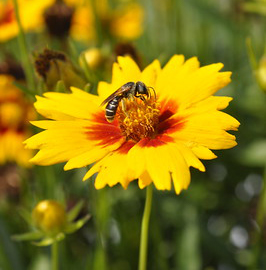
A bee visiting a composite flower (coreopsis).
Credit: UF/IFAS Heather Kalaman
Did you know that Florida is home to more than 300 species of native, wild bees? Approximately 29 of these species are endemic — found only in Florida. Buzzing bumblebees come to mind, but there are also sweat bees, carpenter bees, leafcutter bees, and hundreds more.
Honey bees (Apis mellifera), while naturalized to Florida, are actually native to Eurasia. These amazing bees produce not only honey, but also pollinate one-third of the food we eat.
Our native bees aren't managed for honey production but they are still important pollinators. Recent research is teaching us that it may be possible for crops like watermelon and other cucurbits to be pollinated in part by native bees rather than by managed honeybees. The more we know about our native bee species, the more we can do to sustain and protect them.
Researchers at UF/IFAS ask questions like "do native bees prefer native flowers?" Based on research like this we've learned that some native bee species are generalists. Generalist bees collect nectar and pollen from a wide variety of flower species. These bees don't seem to be fazed by non-native blooms. Bumblebees are an example of a generalist bee. Other native bees are specialists and have tightly-woven relationships with a specific native plant. The Gulf Coast evening bee (Hesperapis oraria) for example, only gathers pollen and nectar from one plant, Balduina angustifolia. For these specialist bees, native plants are the only option.
Clearly there is more to bees and bee gardening than meets the eye. The suggestions below will help you create a garden that welcomes honey bees and Florida's native and non-native bees to your landscape.
Major Components of a Successful Bee Garden
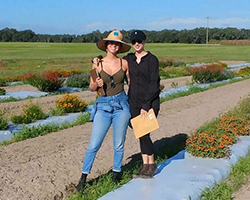
UF field researchers Heather Kalaman and Nicole Hazlett in their pollinator research field. Credit: UF/IFAS Heather Kalaman
Year-round food source: Bees are foragers, collecting pollen and nectar as they move from flower to flower. If your yard is without blooms for a season, your area's bees will go in search of other flowers. To keep your local bees happy and well-fed, aim to have at least three plants flowering at any given point in the year. Our article "Wildflowers for All Seasons" can help you select plants to keep your garden blooming all year long.
Shelter variety: Although the image of a honey bee hive is iconic, very few bees species live in structures like this. Some bees make use of "pollinator hotels," but about 70% of Florida's native bees nest in the ground. To provide shelter for these solitary, ground-dwelling bees, leave some areas of your landscape unmanaged. Dry, bare ground that isn't covered by a fabric or plastic weed barrier provides an ideal habitat for ground-nesting bees. Leave grasses and perennials in these bee-friendly areas untouched, too. Native bees will build nests in the hollowed-out stems.
Water source: Like butterflies, bees also like shallow mud puddles as their source of water and minerals. A water source with a small fountain allows bees easy and consistent access to water for drinking and thermoregulation. Mason bees even use mud for making their nests!
Pesticide-free zone: You can make your garden safe for bees by using pesticides only when needed. Don't spray during the day or when plants are flowering. These are the times when bees are most active. Read the labels carefully, too, before you apply other landscaping products. Occasionally pesticides are part of combination formulas. Read more in "Bees and Pesticides."
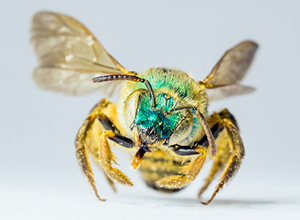
A green metallic sweat bee, one of Florida's native bee species.
Healthy plants, healthy bees: Ongoing research suggests that drought conditions negatively affect nectar quality and production. Keep your garden well-watered and your soil rich to offer bees flowers with a high nutritional content.
Choosing Plants for Your Bee Garden
A garden that attracts native bees will include a mix of annuals, perennials, herbs, shrubs, and trees. Most bee species prefer yellow, white, blue, and purple flowers; they can't see the color red. They prefer daisy-like flowers with broad petals that offer a large landing pad. Native bee preferences vary but many prefer fruiting trees and native plants and shrubs.
Below are our suggestions for those starting a bee garden. For a more extensive list of recommendations, including bloom period and region, consult the UF/IFAS publication, "Attracting Native Bees to Your Florida Landscape."
Composite flowers: Bees have short proboscises (tongues). Unlike hummingbirds, they prefer flowers with wide, flat shapes rather than long, tube-like shapes. Consider blanket flower, coreopsis, Stokes' aster, beach sunflower, and black-eyed Susan.
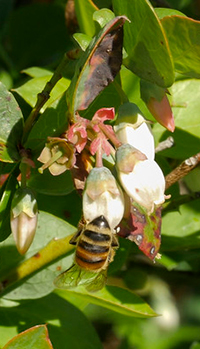
Bee on blueberry flowers.
Clustered flowers: Flying requires huge amounts of energy, and bees conserve it when they can. By visiting flowers that grow in clusters they spend less energy flying from bloom to bloom. Plants like beautyberry, horsemint, salvia, Georgia calamint, false rosemary, and powderpuff mimosa offer bees conveniently close blooms.
Woody ornamentals and trees: Commonly overlooked in designing pollinator gardens, trees and shrubs provide a reliable and abundant source of pollen and nectar year after year. Many bloom in the winter and early spring, too, when food sources are scarce. Consider adding a saw palmetto, chastetree, sweet acacia, buttonbush, or a native plum to your garden.
Native plants: As noted above, some native bees have ecological relationships with native flowers. Native plants provide other ecosystem services, too. A word of caution however: commercially bred cultivars are sometimes confusing to pollinators. If the flower size, shape, or color has been significantly altered in the breeding process, bees might not recognize it as a food source. If you notice bees ignoring a specific cultivar in your bee garden it may be a good idea to replace it with something more attractive to them.
Container plantings: Do you live in an urban area? Even without an extensive landscape, your little slice of Florida can still support bees. Many of the plants above will grow happily in container gardens. Your patio, sidewalk, or balcony will be a rest stop that Florida's bees appreciate as they forage in your urban area.
A final word of advice on choosing flowers for a bee garden: put the right plant in the right place. Choose only plants appropriate for your garden's location. Understand each plant's basic water, light, and soil requirements before you purchase them. The right flower in the right place will perform well and sustain more bees than one struggling in the wrong area.
For more information on Florida's bees and bee gardening, contact your county Extension office.
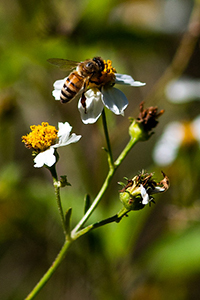
Bee on native Spanish needle.
Also on Gardening Solutions
- Backyard Beehives
- Florida's Keystone Plants
- Gardening for Butterflies
- List of plants that attract bees
- Pollinator Hotels
- Wildflowers for all Seasons
- Wildflowers in the Garden
- Bees and Pesticides
More from UF/IFAS
- Attracting Native Bees to Your Florida Landscape
- Beekeeping Publications in EDIS
- Florida Bee Garden Tool -- Florida-Friendly Landscaping™
- Heather Kalaman presents pollinator plant research (YouTube)
- University of Florida Bee College
Other Sites
- Beekeepers Association of Southwest Florida
- Florida State Beekeeping Association
- Tampa Bay Beekeepers Association

